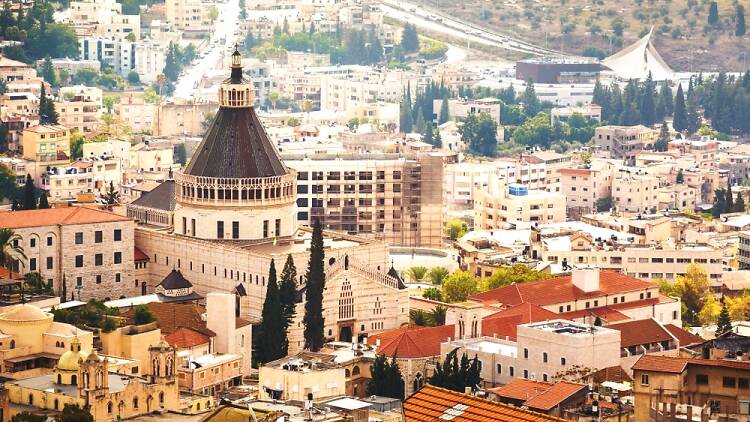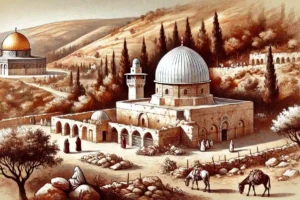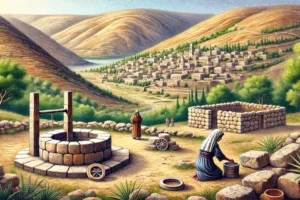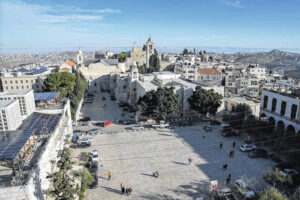
Nazareth: Jesus’ Childhood Home
- Historical Setting: Nazareth was a small Jewish village in the Galilee region during the 1st century, known for its modest size and population.
- Biblical Significance: It is celebrated as the childhood home of Jesus Christ, where he was raised by Mary and Joseph.
- Gospel References: Nazareth is mentioned in the New Testament, notably in the Gospels of Matthew and Luke, which narrate the Annunciation (the announcement of Jesus’ forthcoming birth) to Mary by the angel Gabriel.
- Cultural Context: In Jesus’ time, Nazareth was characterized by its agricultural lifestyle, deeply rooted in Jewish traditions and laws.
- Archaeological Insights: Excavations in Nazareth have unearthed remains dating back to the time of Jesus, offering insights into the daily life, housing, and tools of its ancient inhabitants.
- Religious Significance: Today, Nazareth is a focal point for Christian pilgrimage, boasting significant religious sites such as the Basilica of the Annunciation and St. Joseph’s Church.
- Modern Day Nazareth: Currently, Nazareth is the largest Arab city in Israel, with a diverse population of both Christians and Muslims.
- Cultural Heritage: The city offers a rich cultural heritage, including historical sites, churches, and markets, reflecting the blend of traditions that have coexisted there over millennia.
- Educational Impact: Nazareth’s story and its association with Jesus play a crucial role in Christian education, serving as a key example of faith, humility, and divine purpose.
Nazareth, a city steeped in biblical history, stands as a testament to the profound narrative of Christianity. Situated in the northern region of Israel, within the lush landscapes of Galilee, it holds a place of unparalleled significance as the childhood home of Jesus Christ. This quaint village of the 1st century, largely Jewish in its population, served as the backdrop for the early years of Jesus, under the nurturing care of Mary and Joseph. Its mention in the canonical Gospels, particularly in the accounts of Matthew and Luke concerning the Annunciation, underscores its pivotal role in the Christian faith.
In the time of Jesus, Nazareth was emblematic of a simple, agricultural lifestyle, deeply entrenched in Jewish customs and religious observance. Despite its modest beginnings and the initial skepticism about its significance—captured in Nathanael’s question, “Can anything good come out of Nazareth?” (John 1:46)—it emerged as a cornerstone of Christian pilgrimage, attracting believers from around the globe. The town’s archaeological remnants, dating back to Jesus’ era, offer a tangible link to the past, enriching our understanding of the historical and cultural context of his teachings.
Today, Nazareth is celebrated not only for its sacred history but also as a vibrant community, reflecting a mosaic of Christian and Muslim residents. It hosts revered sites such as the Basilica of the Annunciation and St. Joseph’s Church, standing as enduring symbols of faith and devotion. The evolution of Nazareth, from a humble village to a city of religious importance, mirrors the transformative message of Christianity itself—a message of hope, redemption, and universal love, rooted in the humble beginnings of its founder, Jesus Christ.
Historical Context
Historically, Nazareth was a small Jewish village nestled in the hills of the Galilee region during the Roman Empire’s reign. Its first-century context was marked by a modest population engaged primarily in agriculture and possibly crafts related to the nearby city of Sepphoris, an urban center of the time. Despite its small size, the strategic location of Nazareth within Galilee placed it at a crossroads of cultures, ideas, and political movements, contributing to the diverse socio-political landscape Jesus would later engage with in his ministry.
Archaeological Insights
Archaeological excavations in Nazareth have uncovered remnants of ancient habitation, including houses, cisterns, and agricultural implements, dating back to the time of Jesus and earlier. These findings offer invaluable insights into the daily life, economic activities, and architectural styles of the period, grounding the Gospel narratives in a tangible historical context. Notably, discoveries such as the 1st-century “Nazareth House” beneath the Sisters of Nazareth Convent provide a glimpse into the living conditions of a typical Jewish family in Galilee, underscoring the humble origins of Jesus.
Religious Significance
From a religious perspective, Nazareth holds profound significance in Christianity as the setting of key biblical events, most notably the Annunciation. The Basilica of the Annunciation, a marvel of contemporary church architecture, marks the traditional site where the Angel Gabriel announced to Mary that she would bear the Son of God. This and other sites, such as St. Joseph’s Church, which is believed to stand over Joseph’s carpentry workshop, have made Nazareth a focal point of Christian pilgrimage, embodying the faith’s incarnation principle.
Socio-cultural Dynamics
Modern Nazareth is a vibrant city that represents a blend of cultures, religions, and traditions. It is the largest Arab city in Israel, with a significant population of both Christians and Muslims, reflecting a rich tapestry of Middle Eastern life. This coexistence of diverse communities within Nazareth today offers a unique perspective on contemporary issues of religious identity, cohabitation, and heritage conservation, all while continuing to draw pilgrims and tourists interested in its sacred history and cultural heritage.
Theological Reflections
Nazareth’s significance extends into theological reflections on the nature of Jesus’ mission and the Christian message. Jesus’ upbringing in Nazareth, a place of no great renown, underscores themes of humility, the reversal of social expectations, and the hiddenness of the divine. It challenges believers to find the sacred in the ordinary and to recognize the potential for transformation in the most humble of beginnings.
In conclusion, Nazareth provides a rich field for historical, archaeological, religious, and socio-cultural study, offering layers of meaning that go beyond its physical boundaries. Its significance in the Christian tradition as the childhood home of Jesus adds depth to the understanding of the Gospel narratives, while its modern embodiment as a city of diverse faiths speaks to the ongoing relevance of its message of peace and reconciliation. The comprehensive analysis of Nazareth reveals it as a microcosm of the complex interplay between history, faith, and culture that characterizes the broader Middle Eastern context and the Christian experience.
Tag:Angel Gabriel, Arab city in Israel, archaeological insights, Basilica of the Annunciation, carpentry workshop, Christian and Muslim communities, Christian pilgrimage, contemporary church architecture, cultural heritage, divine hiddenness, Galilee, Gospel narratives, historical context, humility, Jesus' childhood home, Jewish village, Mary, Middle Eastern culture, Nazareth, peace and reconciliation, religious significance, Roman Empire, sacred history, socio-cultural dynamics, Son of God, St. Joseph's Church, theological reflections



